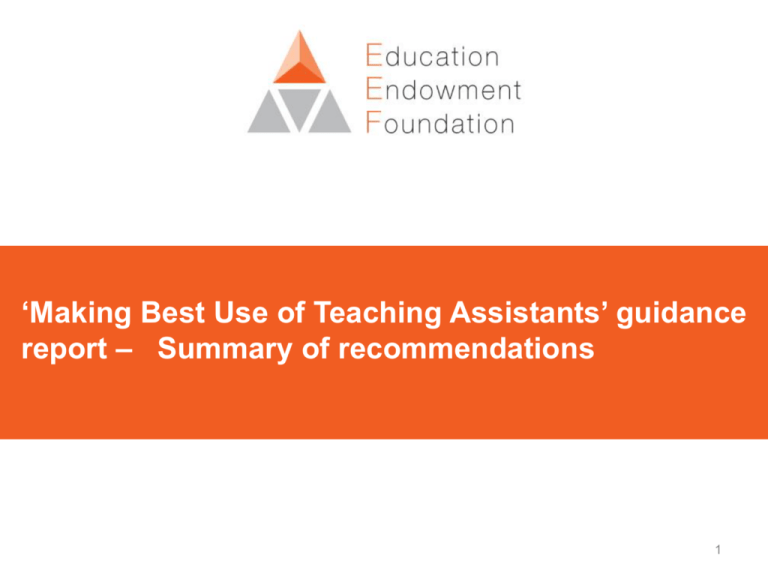Making Best Use of Teaching Assistants
advertisement

‘Making Best Use of Teaching Assistants’ guidance report – Summary of recommendations 1 Who we are • The Education Endowment Foundation (EEF) is an independent grant-making charity dedicated to breaking the link between family income and educational achievement. • The EEF was founded in 2011 by lead charity The Sutton Trust, in partnership with Impetus Trust (now part of Impetus-The Private Equity Foundation) with a £125m grant from the Department for Education. • Together, the EEF and Sutton Trust are the government-designated ‘What Works’ centre for improving education outcomes for schoolaged children. The EEF approach Summarise the existing evidence Share and promote the use of evidence Make grants Evaluate projects The Toolkit is a starting point for making decisions Example: Teaching Assistants The rise and rise of TAs ~250,000 TAs in English schools More TAs than teachers in primary Trebled since 2000 Largest Pupil Premium investment More than roads, housing ~£5bn to employ What an opportunity! ‘Making best use of TAs’ campaign in S and W Yorkshire • £5m funding to support schools in S&W Yorks to maximise the use of TAs. Build momentum in the region • EEF producing the evidence – six partners in the region ‘bringing it to life’ (eg TSAs/LA collaborations). Working with 100s of schools • A series of events, workshops, action planning activities for senior/middle leaders • Backed up by free or heavily subsidised training for TAs to deliver high-quality maths/literacy interventions (recruiting Jan 2016). ‘Making best use of TAs’ guidance report • Clear and actionable guidance • Digs deeper into EEF evidence (eg Teaching and Learning Toolkit) and relates it to the wider evidencebase • A foundation for scale up actions 7 recommendations on ‘Making best use of TAs’ • Has been drift towards TAs taking on role of ‘primary educator’ for lowattaining/SEN pupils. Well-meaning, but flawed. • Results in greater separation from the classroom, teacher, mainstream teaching/curriculum coverage, and their classmates. Associated with significantly lower learning outcomes. • School leaders must review roles of TAs and teachers. Take a wider view of how TAs can support learning and improve attainment. • Schools must break away from the ‘Velcro’ model of TA deployment. • If TAs have a direct teaching role, it is important to ensure they supplement rather than replace the teacher. • Teachers need to use TAs more strategically to enable themselves to work more often with lower-attaining/SEN pupils. • High quality teaching, by the teacher, is the foundation for all the recommendations • Improve the nature and quality of TAs’ talk to pupils to help pupils develop the independent learning skills associated with improved learning outcomes. • Instead of prioritising task completion and correction, TAs should be encouraged to give pupils ‘the least amount of help first’. • TAs’ interactions should help pupils to develop ownership of tasks and to be comfortable to take risks with their learning. Using TAs in the classroom • Lack of opportunities for out-of-class liaison can result in poor teacher-TA collaboration in the classroom. • Schools must provide sufficient time for teachers and TAs to prepare for lessons and for feedback afterwards. • TAs should not ‘go into lessons blind’. Teachers must provide the essential lesson ‘need to knows’ ahead of time. • TAs must be fully trained for roles they are given; for example, in having effective interactions with pupils. • Given the right support and training, TAs can make a significant contribution to pupil attainment delivering 1-2-1/small group interventions (0.2 – 0.3 ES, 3 to 4 additional months progress) . • Positive effects only observed in structured settings, with high-quality support and training. • When TAs deployed in informal, instructional roles they can negatively impact on pupils’ learning (DISS study). Switch on Reading • One to one literacy intervention with children in Year 7 who are struggling with literacy (not achieving level 4 at KS2) • Draws on Reading Recovery. Delivered by teaching assistants, 20mins/day over 10 weeks. • Previous research shows a positive effect (inc. Reading Recovery). • RCT in 19 schools with 300 pupils • Attainment measured using standardised literacy measures • Independent evaluation by Durham University • Observations and interviews to inform how and why the approach might be working http://educationendowmentfoundation.org.uk/projects/category/primary Switch On Reading Number of pupils Effect size* Estimated months’ progress All pupils 308 +0.24 +3 Lower attainers 156 +0.39 +5 FSM-eligible 98 +0.36 +4 SEN reported 225 +0.31 +4 Group Switch On Reading - Conclusions Key Conclusions 1. Switch-on Reading appears to be effective for weak and disadvantaged readers at the stage of transition to secondary school. 2. It can be delivered by teaching assistants after two-days of training, and full training and support is required for all relevant staff. 3. Challenges to successful implementation may include timetabling and the availability of age-appropriate texts. 4. There is a tendency for some staff to stray away from the explicit schedule and this is likely to reduce the programme’s impact. Regular monitoring will increase fidelity but may also increase cost. Catch Up Numeracy and Literacy • Targeted one-to-one interventions, delivered by TAs, for pupils struggling with numeracy and literary • Support is tailored to the needs of the learner • 2 x 15min sessions per week, for 30 weeks • Two, large, independent RCT evalulations (54 and 85 schools respectively) Number of pupils Effect size* Estimated months’ progress Catch Up Numeracy vs control 336 +0.21 +3 Catch Up Literacy vs control 557 Group +0.12 +2 Teaching Assistants: promising results Project Summary Age Toolkit areas Effect size Catch Up Literacy One-to-one tailored TA support on phonics and comprehension. Years 3-6 Phonics +0.12 (2 months) Catch Up Numeracy One-to-one TA numeracy instruction for struggling learners Years 2-6 Nuffield Early Language Intervention Oral language intervention for nursery and reception pupils, delivered by TAs EYFS REACH Language and comprehension intervention for struggling readers, delivered by TAs Year 7 10 week TA intervention drawing on Reading Recovery Year 7 Switch-on Reading Talk for Literacy Speaking and listening interventions delivered by TAs. Year 7 - +0.21 (3 months) Communication and language approaches (Early Years toolkit) +0.27 (4 months) Reading comprehension; Oral language +0.34 (4 months) Reading comprehension +0.24 (3 months) Oral language 0.2 (3 months) Padlocks and stage Effectiveness Effectiveness Efficacy Efficacy Efficacy Efficacy Characteristics of effective interventions: • Brief (20-50mins), regular (3-5 times per week) sessions maintained over a sustained period (8-20 weeks). Carefully timetabled • Extensive training from experienced trainers/teachers (5-30hrs) • Structured supporting resources and lesson plans, which are followed closely • Assessments used to identify pupils, guide areas for focus and track progress Examples of evidence-based interventions include Catch Up Numeracy, Catch Up Literacy, Switch-on Reading, Talk for Literacy, Reading Intervention Programme See EEF website for latest evaluation findings and new TA projects Overall use of interventions: • One or two well-chosen, evidencebased interventions, used judiciously to support pupils that are struggling with their learning • At least compensate for time out of class • Don’t assume pupils can make connections with the general curriculum • Supplement ‘quality first’ teaching in the classroom, with clear links made between learning in each context Supporting resources and tools Available to use and adapt: • Hard copies of the report • Poster summarising the recommendations • Powerpoint slides • ‘Acting on the evidence’ review/plan/do process • Online audit tools (Leaders and Teachers/TA survey) – starting point • Red, Amber, Green (RAG) checklist – direction of travel • Classroom observation proforma • Interventions health check Interventions ‘Health check’ • What does your data show for those pupils involved in intervention work? • Are you using evidence-based interventions? If so, are they being used as intended, with the appropriate guidance and training? • If not, do they reflect the characteristics of effective interventions? • Is appropriate planning provided for timetabling out-of-class sessions so that they complement classroom teaching? • How effective are TAs and teachers reviewing work taking place in intervention sessions? Are pupils supported to make links being made with general classroom work?


